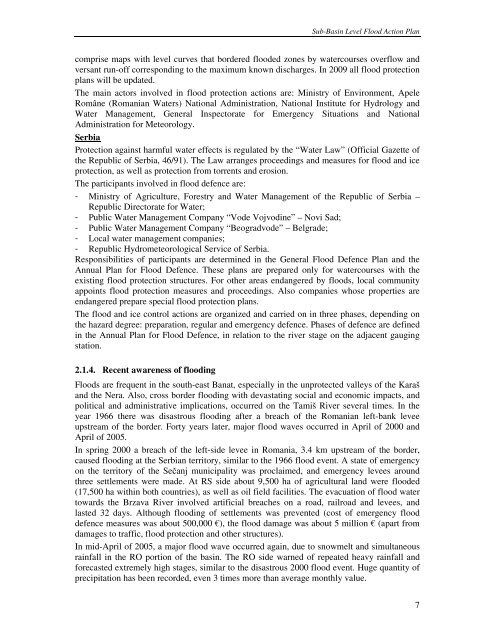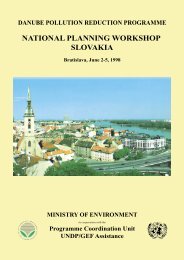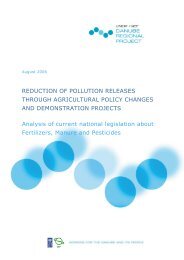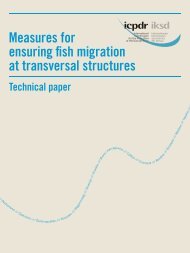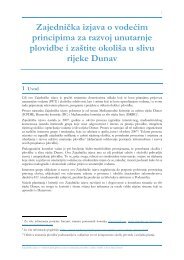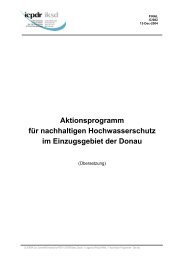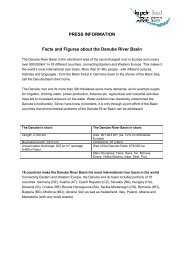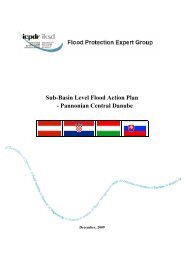Sub-Basin Level Flood Action Plan - Banat Sub-basin - - ICPDR
Sub-Basin Level Flood Action Plan - Banat Sub-basin - - ICPDR
Sub-Basin Level Flood Action Plan - Banat Sub-basin - - ICPDR
You also want an ePaper? Increase the reach of your titles
YUMPU automatically turns print PDFs into web optimized ePapers that Google loves.
<strong>Sub</strong>-<strong>Basin</strong> <strong>Level</strong> <strong>Flood</strong> <strong>Action</strong> <strong>Plan</strong><br />
comprise maps with level curves that bordered flooded zones by watercourses overflow and<br />
versant run-off corresponding to the maximum known discharges. In 2009 all flood protection<br />
plans will be updated.<br />
The main actors involved in flood protection actions are: Ministry of Environment, Apele<br />
Române (Romanian Waters) National Administration, National Institute for Hydrology and<br />
Water Management, General Inspectorate for Emergency Situations and National<br />
Administration for Meteorology.<br />
Serbia<br />
Protection against harmful water effects is regulated by the “Water Law” (Official Gazette of<br />
the Republic of Serbia, 46/91). The Law arranges proceedings and measures for flood and ice<br />
protection, as well as protection from torrents and erosion.<br />
The participants involved in flood defence are:<br />
- Ministry of Agriculture, Forestry and Water Management of the Republic of Serbia –<br />
Republic Directorate for Water;<br />
- Public Water Management Company “Vode Vojvodine” – Novi Sad;<br />
- Public Water Management Company “Beogradvode” – Belgrade;<br />
- Local water management companies;<br />
- Republic Hydrometeorological Service of Serbia.<br />
Responsibilities of participants are determined in the General <strong>Flood</strong> Defence <strong>Plan</strong> and the<br />
Annual <strong>Plan</strong> for <strong>Flood</strong> Defence. These plans are prepared only for watercourses with the<br />
existing flood protection structures. For other areas endangered by floods, local community<br />
appoints flood protection measures and proceedings. Also companies whose properties are<br />
endangered prepare special flood protection plans.<br />
The flood and ice control actions are organized and carried on in three phases, depending on<br />
the hazard degree: preparation, regular and emergency defence. Phases of defence are defined<br />
in the Annual <strong>Plan</strong> for <strong>Flood</strong> Defence, in relation to the river stage on the adjacent gauging<br />
station.<br />
2.1.4. Recent awareness of flooding<br />
<strong>Flood</strong>s are frequent in the south-east <strong>Banat</strong>, especially in the unprotected valleys of the Karaš<br />
and the Nera. Also, cross border flooding with devastating social and economic impacts, and<br />
political and administrative implications, occurred on the Tamiš River several times. In the<br />
year 1966 there was disastrous flooding after a breach of the Romanian left-bank levee<br />
upstream of the border. Forty years later, major flood waves occurred in April of 2000 and<br />
April of 2005.<br />
In spring 2000 a breach of the left-side levee in Romania, 3.4 km upstream of the border,<br />
caused flooding at the Serbian territory, similar to the 1966 flood event. A state of emergency<br />
on the territory of the Seanj municipality was proclaimed, and emergency levees around<br />
three settlements were made. At RS side about 9,500 ha of agricultural land were flooded<br />
(17,500 ha within both countries), as well as oil field facilities. The evacuation of flood water<br />
towards the Brzava River involved artificial breaches on a road, railroad and levees, and<br />
lasted 32 days. Although flooding of settlements was prevented (cost of emergency flood<br />
defence measures was about 500,000 €), the flood damage was about 5 million € (apart from<br />
damages to traffic, flood protection and other structures).<br />
In mid-April of 2005, a major flood wave occurred again, due to snowmelt and simultaneous<br />
rainfall in the RO portion of the <strong>basin</strong>. The RO side warned of repeated heavy rainfall and<br />
forecasted extremely high stages, similar to the disastrous 2000 flood event. Huge quantity of<br />
precipitation has been recorded, even 3 times more than average monthly value.<br />
7


